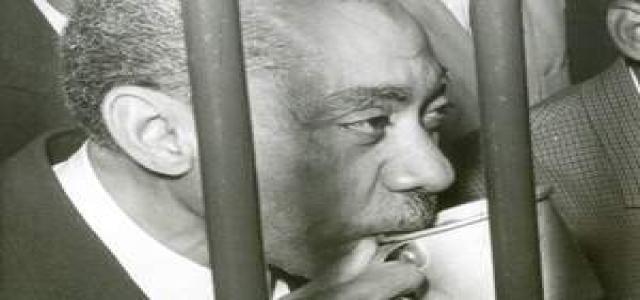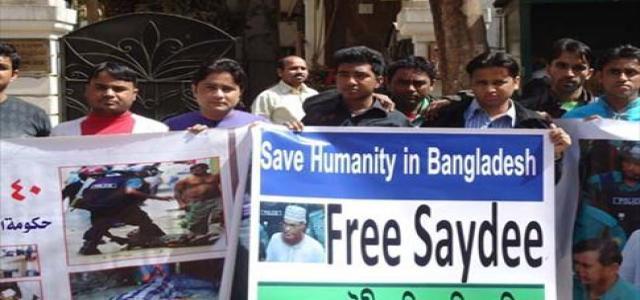- Other Views
- September 17, 2010
- 9 minutes read
Sayyid Qutb, man of his era

During the Second World War, Sayyid Qutb commuted to his government job in central Cairo on a train that ran north from his home in the suburb of Helwan. Qutb worked as a school inspector, but was also a man of letters who wrote novels, poetry and criticism. The Egyptian Nobel Laureate Naguib Mahfouz later credited Qutb as one of two literary critics who had been “responsible for rescuing him from obscurity”: Qutb had praised Mahfouz’s early novel The Struggle of Thebes, an allegory of Egypt’s anti-colonial struggle against the British told through the ancient Egyptians’ battle with the Hyksos invaders. In an interview in the 1990s, Mahfouz remarked that “had it not been for his tendency to extremism,” Qutb “would have become the most important critic in Egypt.”
Needless to say, this is not the picture of Qutb that exists today. In the nine years since September 11, Qutb has been enshrined as the intellectual father of radical Islam, the man whose ideas explain the beliefs of the 19 hijackers who crashed planes into the World Trade Center and the Pentagon – the inspiration, in other words, for an entire generation of Salafi jihadists. But as the historian John Calvert writes, in an extensive and vital new biography, the consensus that “the road to 9/11 traces back” directly to Qutb is ill-founded, based on a limited understanding of Qutb himself and an oversimplified account of the evolution of political Islam.
“Read backwards from the event of 9/11,” Calvert writes, “these accounts enfold Qutb in the al Qa’eda mantle in an attempt to make the variegated history of the Islamic movement into a cohesive narrative.” Relying on “short cuts” ignores a complex history and “subordinates particulars to an essential and enduring identity.” Against the anti-Muslim catcalls of right-wing politicians and “liberal hawk” writers like Paul Berman, who style themselves defenders of western culture against a singular Islamic tide, Calvert reads as a refreshing and scholarly rebuke: “Just as it makes no sense to confuse the outlook of Hamas, an organisation focused on redeeming land lost to Israel, with the pan-Islamism of al Qa’eda, so too is it unwise to assume a direct link between Sayyid Qutb and Usama bin Laden.”
How did a writer and educator from Egypt’s new, urban middle class, whose early biography matches that of the cosmopolitan secularist Mahfouz, become an Islamist dissident who railed against – and was executed by – Gamal Abdel Nasser, the hero of the post-colonial Arab world? Calvert finds an answer in the social and political upheavals that convulsed Egypt in the middle of the 20th century. In careful prose, backed by volumes of archival research, Calvert situates the development of Qutb’s radicalism against the colonial and post-colonial struggles that framed the Second World War – a time when the Middle East was a hotbed of pan-Arab and Third-Worldist social movements in opposition to imperialism, Communism and the Cold War.
Calvert treats Qutb as a subject of history in his own right, and not merely as an “Islamo-fascist” caricature; and in so doing represents Qutb as an example of the possibilities and uncertainties of his era. In Calvert’s narrative, we trace Qutb’s development from transplanted villager and young, mostly secular nationalist in Cairo to budding Muslim reformer who described Islam as an economic, social and political corrective to the region’s malaise – from King Farouq’s acceptance of Britain’s hold over Egypt to the Zionist colonisation of Palestine.
In 1948, after Qutb formalised his ideological shift by completing Social Justice in Islam, his first major Islamist work, he left for America on a government-sponsored trip to study America’s education system. He was 42. In the popular narrative of Qutb’s radicalisation, these two years – in particular his time in Greeley, Colorado – ignited an anger at the West that he carried home. But as Calvert argues: “Qutb’s American experience reinforced, rather than provoked, the development of his Islamist sentiment.” He saw America as shallow, materialist, the vacuous Other to his own virtuous Self. Calvert retells this sojourn in detail. Qutb visited the San Francisco Museum of Modern Art ten times to stare at the same French painting, “bothered” that so many Americans ignored it. He also confessed to liking American films; Qutb may have been celibate, Calvert writes, but he “singled out two stormy romances, Gone with the Wind and Wuthering Heights.”
As Egypt grew restless in the lead-up to the 1952 revolution, Qutb’s views hardened into a Third World leftism that placed Egypt in a transnational community of the “Muslim East”. After King Farouq sailed out of Alexandria, the Free Officers courted Qutb, eager to bring the Muslim Brotherhood into the fold, though he had not yet joined the Brothers. He did so the next year, in 1953, to take his side in a quickly deteriorating relationship between the new regime and the Brotherhood. A year later Nasser capitalised on a failed assassination attempt to round up the Brotherhood and neutralise his Islamist opponents.
Qutb spent nearly a decade in Tura prison. In foul conditions and under the tortuous treatment of Egypt’s police, his radicalism was fully formed. Displaying his scars to a court in 1955, he declared: “Abdel Nasser has applied to us in jail the principles of the revolution.” In this time he wrote Milestones, a short, radical text in which Western materialism and contemporary Arab society are cast as signs of modern jahiliyya or ignorance, a term meant to connote pre-Islamic Arabia. He included both secular pan-Arab governments and the prevailing religious order in his damning critique. Based on a voluminous study of the Quran that he also completed while incarcerated, Milestones popularised Qutb’s view of Islam as a complete societal and moral system for Egypt and the wider ummah.
After a brief release in 1964, Qutb was imprisoned again in another government sweep against the banned Muslim Brotherhood, which had reformed and plotted a government overthrow. Nasser was wary of making him a martyr, but when Qutb refused the “Pharaoh’s” offer of clemency, he was hanged in 1966. It had taken the government six months to ban Milestones, then on its fifth printing. Qutb’s death, and the subsequent failure of Nasserism after Israel’s victory in 1967, shook a generation of young people, among them Ayman al Zawahiri, a 15-year-old living in Maadi who went on to help found the Islamist group that assassinated Anwar Sadat. When Zawahiri was detained after Sadat’s death, he and other perpetrators were tortured, and their courtroom testimony echoed Qutb’s own experience under Nasser.
Qutb’s ideology did not spring unaltered from the Quran, despite his religious devotion, but was an articulated response to his age. Like Hassan al Banna, the founder of the Muslim Brotherhood, he was a kind of rebel layman, writing and preaching like an evangelist against al Azhar, Cairo’s thousand-year old seat of Sunni learning, which Nasser co-opted. He argued that any Muslim could learn fiqh or religious understanding; divine interpretation was not the sole property of the ulema. His death made him a martyr, and it is through his imprisonment and execution that the extent of his influence ought to be understood. Qutb’s Radical Islamism “is a fundamental, though disturbing aspect of the modern experience of Muslims,” Calvert concludes, “anchored in the historical record of suppression by imperialist outsiders.”
The Washington Post’s Richard Cohen recently reproached both The Economist and the historian Eugene Rogan for writing about Qutb’s centrality to modern political Islam without a mention of his anti-Semitism – in particular his book Our Struggle with the Jews. The book, Calvert writes, is a paranoid, reductive effort by Qutb to graft the historic discord between the Jews and early Muslims of Medina, told in the Quran, onto the Arabs’ modern-day struggle against Zionism. It is propaganda of a textual fundamentalist, which Qutb was. But remarking on it or not should not define all commentary on Qutb. Similarly, that the nihilists of al Qa’eda have adopted Qutb’s discourse of jahiliyya does not mean that Qutb would have endorsed its horrific programme. He never advocated killing innocents and despite invoking worldwide “ignorance” never labelled people kafirs.
Despite his discontents with America, Qutb would probably have been disturbed by September 11. Bin Laden and Zawahiri reversed the order of Qutb’s theory regarding societal and systemic change, Calvert argues, “which advocated as a first step the eradication of the perceived corruption at home”. More central to Qutb’s struggle and the durability of his radical message, therefore, is the fact that it was Nasser – Egypt’s first modern autocrat – who put him to death.



